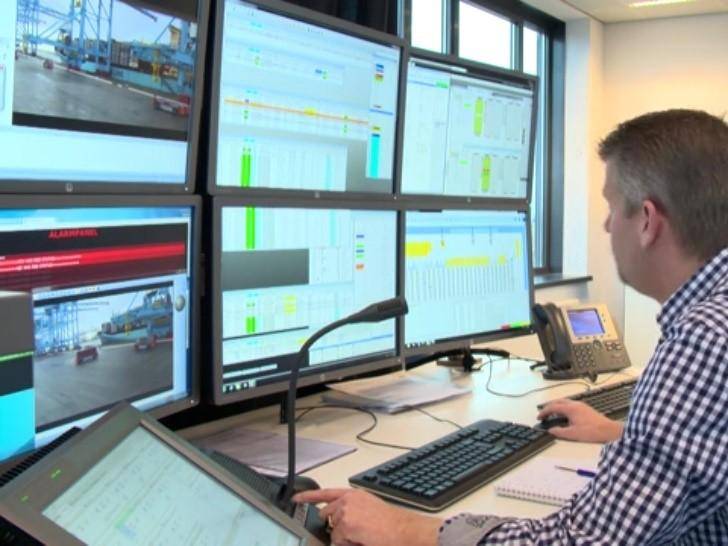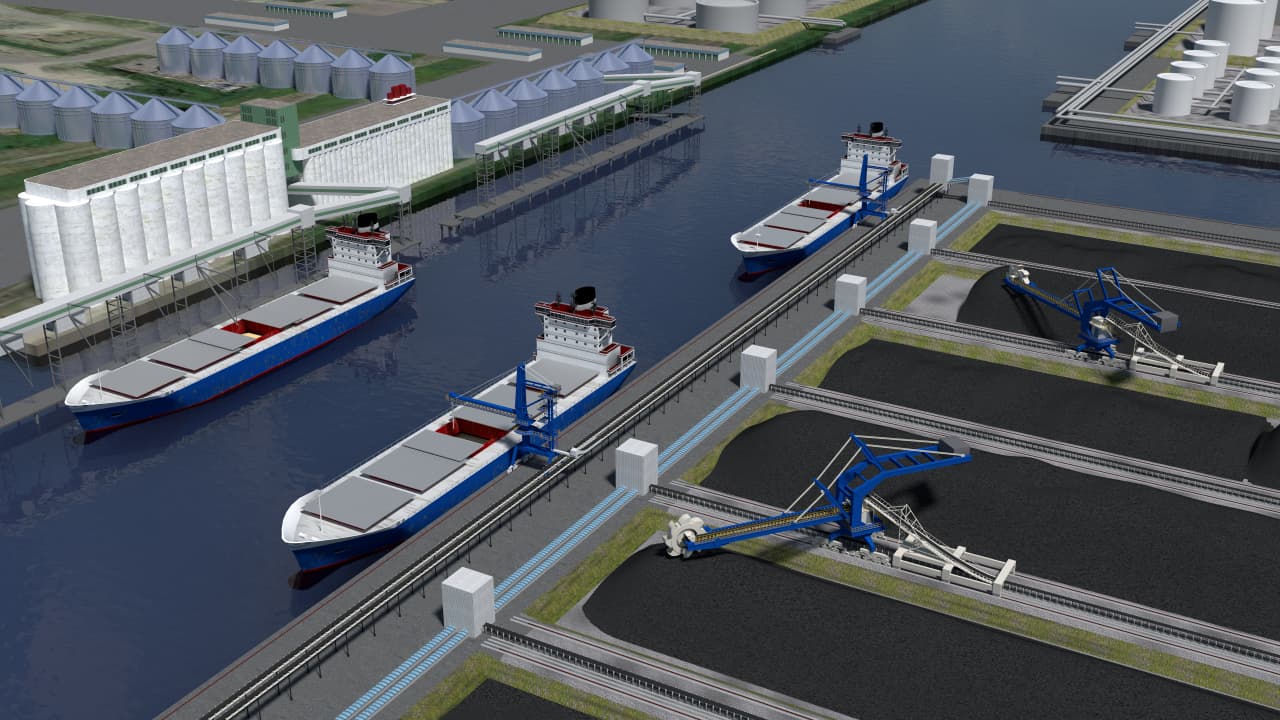Handling of solid biomass from the perspective of dry bulk terminals
Many dry bulk terminals have experienced the increase in biomass handling because of the use in feed and food sector, the recent technical development in bioenergy, and several governmental energy policies (e.g. EU directives) [1]. Normally the biomass for the application in the feed and food sector (e.g. corn, oats, soy meals, barley) is handled by grain terminals. However, because of the wide range of applications in the energy sector, the handling of solid biomass materials has been seen also in other dry bulk terminals. Camia et al. estimated that more than 1 billion tons per year of solid biomass has been used in the EU; primarily in the feed and food sector, followed by bioenergy sector and biomaterial (see Figure 1) [1]. IEA has also estimated that by 2040 the demand for bioenergy will exceed 1,850 Mtoe [2].

Figure 1: Distribution of EU-28 biomass uses [1].
Solid biomass comes in various forms (e.g. pellets, chips) and from various sectors (e.g. agriculture, forestry) and increasingly it is being traded in international markets. Bradley et al. [3] have indicated that shipping is the main method to transport solid biomass. In addition, other studies ( [4] [5]) have concluded that the most preferable biomass supply chain is long distance transport via shipping. This implies that marine terminals in ports will be the important hubs within the logistics chain.
Various aspects should be taken into account to have a thorough picture of solid biomass operations: the significant material types for large-scale handling, the implication from the physical/flow properties for cargo handling at the terminal, and the effects caused by the stochastic parameters (e.g. vessel arrival patterns) to the storage capacity and storage time of solid biomass operations. These aspects are further discussed in the following sections.
Material type and physical properties of solid biomass
There are various kinds of solid biomass, but not every type is suitable for being transported over long distances and handled in dry bulk terminals. Important criteria such as potential availability, the application preference/possibility by major users (e.g. power plants) and logistical concerns are the reasons that wood pellets and wood chips are the main feedstocks for bioenergy application. Another solid biomass with good potential is torrefied pellets because its material properties (e.g. higher energy content, hydrophobic), provided that the market implementation in the future will be successful.
It is essential to understand the material properties of these selected solid biomass types, in order to know how to handle and store them properly. Selection and design of handling and storage equipment for solid biomass types strongly depends on their physical material properties/flow properties. Furthermore, the flow properties may also affect the operational process. For a better understanding regarding equipment it is important to look deeper to compare these solid biomass properties with other bulk materials that have been handled and studied frequently, such as coal and grain.

Table 1 shows that there is four times more volume of solid biomass required for the same energy output compared with coal. Solid biomass properties show a much wider range per characteristic, in comparison with soybean and coal. Furthermore, the following aspects are important when it comes to solid biomass fuels from the perspective of a dry terminal:
- Because of the hydrophilic nature of solid biomass fuels, they are sensitive to material degradation. It is recommended to handle and store solid biomass fuels with enclosed or covered equipment/option (e.g. warehouses, covered trough belt conveyors).
- Solid biomass has a strong tendency for self-heating because of bio-activities and potential high moisture content. Thus, certain common prevention measures performed for coal handling (e.g. compaction) increase the risk of selfheating.
- Equipment designed for coal handling is suitable for the operation of solid biomass fuels. However, the handling processes/methods need to be adjusted according to the material properties.
- Because of the low bulk density, more equipment (capacity) is required for the same tonnage handling performance. For solid biomass handling, the volumetric performance should be the main benchmark rather than tonnage performance.
Impact from stochastic elements to storage capacity and storage time
It is challenging to simply calculate the storage capacity as a result from the following factors:
- the supply seasonality;
- the arrival patterns of the incoming and outgoing flows;
- the size composition of the vessels/inland transportation);
- the operational strategies and process at the dry bulk terminal; and
- the operational stoppages (e.g. rain, equipment breakdowns).
Dynamic simulation tools are increasing used to make such an estimation for:
- the ability to cope with the above-mentioned stochastic elements,
- the capability for quantifying the measurable KPIs (see Figure 2 and Figure 3 for examples),
- and the strength to systematically compare various strategies/options.
It is recommended to use such a simulation approach to design and assess the storage arrangement for the solid biomass handling.
A common demand figure for a power station unit will be about 3 million tons of wood pellets per year and when the choice comes to wood chips even 4-4.5 million tons may be required. Storage facilities for solid biomass require large areas as a result of their low bulk density and energy content (Table 1), to have the same energy output as coal, up to 8 times more volume of solid biomass is required [7]. Furthermore, the need for an uninterrupted supply, power stations typically ask for storage capacities of about 100,000 tons which requires a covered storage around 200,000 m3 (wood pellets). With the same stacking method, 1.3 times more land is needed (lower volumetric performances for biomass) [8].
Several enclosed/covered storage options can be used to store solid biomass, such as silos (assuring a first-in/first-out material flow); flat storage (wide sheds) or domes. The following recommendations apply to all storage options [8]:
- Measures against dry matter loss and material degradation, such as a good ventilation system and pre-drying before storage, should be applied.
- Measures against self-heating should be applied. Such measures can be having homogeneous storage piles (in terms of material particle size distribution), taking the geometry of storage piles into account, avoiding compacted storage piles, etc.
- The storage time of solid biomass should be controlled. Depending on the mois-ture content of the material, the recommended maximum storage time varies from 3 weeks (for fresh wood chips) to 3 months (wood pellets).
- Both storage capacity and storage time are sensitive to arrival and departure patterns. Good logistic control is required.

Figure 2: An example of yearly stock level fluctuation from simulation experiments.

Figure 3: An example of vessel turnaround time from simulation experiments.
Conclusions and recommendations
Currently more and more dry bulk terminals are adding solid biomass into their cargo portfolio. It is expected that significant amount of wood pellets and wood chips will be handled by dry bulk terminals in the future, as well as “new type” of bioenergy feedstocks, such as torrefied pellets.
The material characteristics of solid biomass come with a wide variation range compared to commonly handled bulk materials such as coal or grain; it is necessary to have adjustments in terms of handling process and storage requirement. The low bulk density makes the volumetric requirement more influential than the tonnage demand mostly seen from other commonly handled bulk commodities. Several handling processes need to be adjusted (e.g. enclosed storage, self-heating prevention method) to cope with solid biomass material properties.
An analysis supported with simulation tools is recommended as this allows investigating the combined impact of stochastic events (e.g. material arrival and departure patterns, operational disruptions) and the material characteristics. This approach will result in a better terminal design in terms of berth capacity, equipment utilization, storage capacity and storage time.
About the author
Dr. Mi-Rong (Kimberly) Wu is the principal bulk specialist at TBA Group. She has been involved with logistics, ports and terminals throughout her professional career since 2005. She has over 12 years’ experience in the bulk sector focusing on subjects such as: bulk terminal design, bulk material handling and simulation modelling for bulk terminal
design. TBA’s services have been proven to add value to existing terminals by increasing operational efficiency, supporting existing terminals to plan for future expansion and validating design for terminals. TBA’s project portfolio covers terminals handling biomass, agri-bulk, coal, iron ore, sulphur, sugar and more.
References
[1] A. Camia, N. Robert , R. Jonsson , R. Pilli , S. García-Condado, R. López-Lozano, M. van der Velde, T. Ronzon, P. Gurría , R. M’Barek, S. Tamosiunas, G. Fiore, R. Araujo, N. Hoepffner, L. Marelli and J. Giuntoli, "Biomass production, supply, uses and flows in the European Union: First results from an integrated assessment," Publications Office of the European Union, Luxembourg, 2018.
[2] International Energy Agency (IEA), "The World Energy Outlook 2018," OECD/IEA, 2018.
[3] D. Bradley, F. Diesenreiter, M. Wild and E. Tromborg, "World Biofuel Maritime Shipping Study for IEA Task 40," 2009.
[4] R. Suurs, Long distance bioenergy logistics An assessment of costs and energy consumption for various biomass energy transport chains, Copernicus Institute, Utrecht University. ISBN 90-73958-83-0, January 2002.
[5] C. N. Hamelinck, Outlook for advanced biofeuls -- International bioenergy transport costs and energy balance, Department of Science, Technology and Society, Utrecht University. ISBN 90-393-3691-1, 2004.
[6] M. Wu, "Transitions to biomass handling - A simulaiton approach," in BULK TERMINALS 2017: ACHIEVING EFFICIENCY AND COMPLIANCE, London, 2017.
[7] M. R. Wu, A large-scale biomass bulk terminal, Delft: Delft University of Technology, 2012. ISBN 978-94-6186-076-7.
[8] M.-R. Wu, "Analysing terminal facilities for biomass operations," Port Technology International, pp. 51-54, Edition 60 November 2014.
This article has been published in Dry Cargo International Magazine Issue no. 225. Read the full article here
Share this
You May Also Like
These Related Stories

Turning data into knowledge: Bridging the gap in the terminal industry

Making the transition to digital
